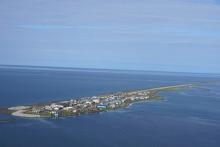On August 6th, the remote Alaskan village of Kivalina awoke to find itself besieged by a bright orange goo. This sludgy orange residue was found floating on the surface of the lagoon and washing up on the village's beaches. Kivalina's 374 residents could only gather and speculate as to what it might be. The village is primarily Inpiat Eskimo, and no one could remember ever having seen such a sight, including the village's elders.
As the goo washed on shore, it dried up in the marine winds and turned powdery. This is presumably how it came to be found in the town's water cisterns and rainwater barrels, some of them located several miles from the lagoon where the orange substance was first found.
Samples of the goo were gathered up in canning jars and sent to Anchorage for analysis. The word came back from NOAA scientists: the goo was actually billions of eggs from an unidentified crustacean. A tiny dot of lipid in the middle of each egg both made it float, and gave it the bizarre orange color.
Although it is somewhat reassuring to learn that the bright orange goo has natural origins (and isn't, for example, some kind of bizarre toxic waste), NOAA scientists are still unable to state whether the eggs are toxic or non-toxic. That's a big problem, because like many remote Alaskan villages, Kivalina often experiences water shortages during the summer months. Kivalina's residents rely on their water barrels in the late summer months, and if this goo has poisoned their water supply, the village will be in big trouble.
The airborne orange powder is also raising some concerns regarding the village's food supply. Kivalina is a subsistence village, and August is the month for berry-picking. What if the orange powder has filtered onto the blueberries and salmonberries that are currently ripe? These berries aren't just a tasty addition to dessert; they are a key component of their summer diet.
It wasn't too long ago that a giant blob of a black goopy substance drifted past Wainwright on the Chuckchi Sea. That particular blob turned out to be a massive bloom of filamentous algae that had partially decomposed by the time it was observed and collected.
First an unprecedented huge bloom of algae, then an unprecedented huge shed of crustacean eggs. What's next for Alaska's shores? And are these strange occurrences connected to climate change? Stay tuned…!
As the goo washed on shore, it dried up in the marine winds and turned powdery. This is presumably how it came to be found in the town's water cisterns and rainwater barrels, some of them located several miles from the lagoon where the orange substance was first found.
Samples of the goo were gathered up in canning jars and sent to Anchorage for analysis. The word came back from NOAA scientists: the goo was actually billions of eggs from an unidentified crustacean. A tiny dot of lipid in the middle of each egg both made it float, and gave it the bizarre orange color.
Although it is somewhat reassuring to learn that the bright orange goo has natural origins (and isn't, for example, some kind of bizarre toxic waste), NOAA scientists are still unable to state whether the eggs are toxic or non-toxic. That's a big problem, because like many remote Alaskan villages, Kivalina often experiences water shortages during the summer months. Kivalina's residents rely on their water barrels in the late summer months, and if this goo has poisoned their water supply, the village will be in big trouble.
The airborne orange powder is also raising some concerns regarding the village's food supply. Kivalina is a subsistence village, and August is the month for berry-picking. What if the orange powder has filtered onto the blueberries and salmonberries that are currently ripe? These berries aren't just a tasty addition to dessert; they are a key component of their summer diet.
It wasn't too long ago that a giant blob of a black goopy substance drifted past Wainwright on the Chuckchi Sea. That particular blob turned out to be a massive bloom of filamentous algae that had partially decomposed by the time it was observed and collected.
First an unprecedented huge bloom of algae, then an unprecedented huge shed of crustacean eggs. What's next for Alaska's shores? And are these strange occurrences connected to climate change? Stay tuned…!
